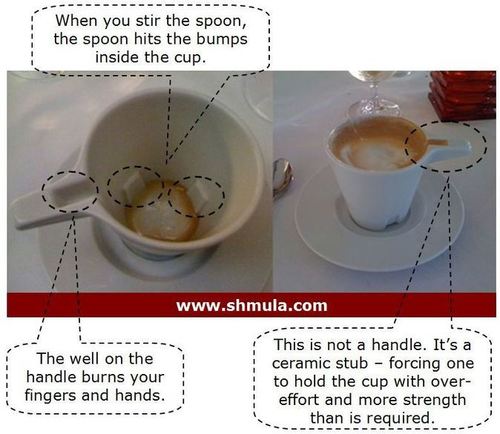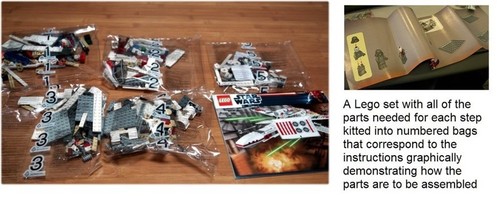Jan 22 2014
Shortage of skills, not yet – but very soon – a wake up call (part 1) | Wiegand’s Watch
This is a translation of the bulk of Bodo Wiegand’s latest newsletter, followed by my comments:
“As long as our support professionals and staff spend less than 50% of their time on their core activities, we have no shortage of skilled workers . But it’s coming — mercilessly, and we are not doing anything about it!
Whenever I ‘m in a company and we discuss about efficiency in the indirect area , the first reaction is disbelief and astonishment, with statements like “Mr. Wiegand, certainly not with us.” When, in the 10/2007 issue of Focus, I wrote “the labor productivity in administration is about 50%” [of what it should be], no one wanted to believe it , or admit it … and it was and is dismissed by most with a ” not with us.”
In fact is it is below 50 % , today as well as yesterday, and if we do not start worrying about it soon and finally wake up from our slumber , we will run into real problems that will jeopardize the existence of our German business model.
Now my dear “not with us” unbelievers and friends – wake up : The facts are coming. According to a study by the AKAD University in Leipzig, each week, office workers spend a whole day in meetings and one whole day processing email. You don’t think so? The proof: Based on a Varonis survey from 2012:
- 4.8% receive 300-500 emails a day ,
- 17.6 %, 100-300 emails a day ,
- 44.8 %, 50-100 emails a day and
- 32.8 %, 1-50 emails a day .
According to a survey conducted by Mimecast and Microsoft Exchange from 2012, from the recipients’ perspective, 61 % of the emails are unnecessary, 25 % are at least useful, and only 14% are “really important.”
Once again in plain text: Nearly 70 % of employees working in offices receive more than 50 messages/day.Assume only 50 emails/day. The processing time per email is about 1-2 minutes, Here is some additional information for the smart alecks who think they only 10 seconds per email: they are among the 70 % who get more than 50 emails/day and don’t read them. The additional mental setup time in normal office activity for one mail is 64 seconds, as calculated by Loughborough University psychologist Thomas Jackson.
It follows that, in the best case , the processing of the assumed 50 mails / day takes at least 2 hours, which works out to 10 hours a week or 55 working days/year. It devours 1 day per week (see also the study by Leipzig’s AKAD University) .
Considering that the processing of 61 % of the mail is a waste of time . This corresponds to 6 hours a week or 38 days per year or 17 % more time for the employee.
Studies have shown that when engineers and developers work constructively or on complex problems , the mental setup time is up to 12 minutes. This group of people needs 250 minutes/day for just 25 mails/day and 10 minutes of mental setup times. It is already makes 50 % of their time. With an average salary of €100,000/year, makes € 50,000/employee for email processing !
So, if we eliminate for this group the 61% of unnecessarily emails , they would receive only 10 mails/day and would thus have 120 minutes more time for their actual work. Then we focus on processing the email in the morning and afternoon , and save another 100 minutes.
Now, how doe we fight this email flood?
- Introduce email etiquette to reduce the number of messages and raise their quality .
- Analyze the structure of the information enhance the quality of information and communication , and stop the sending of unnecessary emails.
Moreover, we should take heed of a more serious study and begin to protect our employees . 63.6 % of all managers believe that is expected of them that they should be accessible in their free time. An survey of German executives in 2013 asked what measures were taken to put limits on their accessibility?
81 % of the executives responded : “None.”
Which is at least one reason for the rise in the burn-out syndrome. If 81 % of the companies do not take this problem seriously , it’s actually only a matter of time before the executives burn out.
It is the duty of the companies to care about this.
Next, let us discuss meetings. How often has each of you experienced meetings
- That have no agenda ,
- Where there no clear tasks have been defined,
- Where there is no clear outcome or agreement on actions and responsibilities,
- Without any follow-up on actions from the last meeting,
- Where the allotted time was exceeded,
- That did not start on time,
- Where someone came too late ,
- In which one or more persons ( Mr. or Mrs. Important) left to make a call ,
- Where computers with emails were answered during the meeting ,
- Where there was little conversation,
- Where documents were issued at the meeting for “fast” decisions,
- Where all agreed at the meeting on a decision and afterwards said “Maybe,”
- Where everything was discussed except the real issues ,
- …
All waste – pure waste .
What can you do so in order to curb the meeting madness and to cut one day meeting per week to four hours ? Change the meeting culture , and take actions to reduce the number of meetings and radically shorten them, such as:
- Put out a guide for improving a culture of dialogue .
- Analyze the structure of discussions to establish which types of meetings are needed. For example, keep routine meetings to up to 30 minutes, standing in front of a whiteboard, and discuss only anomalies. Time savings immediately 50 % guaranteed!
Summing up the potential for meetings and email processing together , can get a relief of more than 15 to 20 % of the time for each .
Hello my dear ” Not with us” friends, if you stick your head quietly in the sand, you do not have to even deal with these issues.
A manager of a large automotive supplier once said to me : ” Mr. Wiegand, in production, we are chasing cents and leaving euro notes on the floor in administration. “So what in the world is holding back our managers from raising their efficiency and thus to relieving much-needed management resources from this senseless workload. They just look and pointlessly waste our most important resouce : our employees , our specialists and managers , our engineers and developers.
Relieve this group from distractions like secretarial work , travel planning and other non-core activities , and you generate further potential , and that without even tackling interface problems , optimizing the processes or breaking down silos.
For this you do not need a consultant , you only need to invest in training your employees.
[…]
In my 15 years of experience with administrative Lean projects, I can see that there a total of at least 20 to 30 % increase in efficiency is possible.
In Part 2 of this topic , we deal with the other 15 to 20% of improvement and how to realize them.”
Bodo Wiegand paints the abuse of email and poor meeting organization as an existential threat to the German business model. According to him, German managers and professionals are only operating at 50% of their capacity because of the time they spend processing unnecessary emails and sitting through meetings that belie the worldwide perception of German promptness and rigor. In fact, as much as I enjoy myth busting, from my personal experience of meetings in Germany, I would not put this issue high on the list of needed improvements. I have seen worse elsewhere.
As for email, even though Wiegand only proposes to improve its use, he seems to be attacking the medium, which he used himself to send out his newsletter. And the countermeasures he proposes address, at best, internal email abuse. If all employees of a company stopped sending each other unnecessary emails, it wouldn’t stem the flow from outside. You can filter it with firewalls but, if you do it too aggressively, you can interfere with necessary communications.
Let’s face it: email is the greatest medium ever invented for one-to-one or one-to-many informal communication in writing. It is informal in the sense that, unlike a form with fields and check boxes, it imposes no structure on the content. It replaces the business letter, but not the purchase order.
It is not perfect. Email over the internet has proven reliable, but it offers no guarantee of delivery, and the fact that you sent a message is no legal proof that any other party received it. And the informality of the medium has led many to let loose and write things that they came to regret when they discovered that email communication is not as private as they assumed it to be, and that completely deleting an email is next to impossible. In essence, all the emails you send become part of your permanent record.
Technically, email does not work well for the many-to-many communication required, for example, in a project team. The members of a team need to post information in one place for the team, and nothing but the team, with tools to collaboratively edit it. This is not accomplished by sending messages to each other, that are stored redundantly in each recipient’s mailbox.
This being said, email today is the primary way business is done, and there is nothing wrong, per se, in having office professionals spend time processing emails. It is only wrong if they do too much of it, but there is no universal rule on the amount they need to do their jobs; it depends on what their jobs are. It won’t be the same in marketing and in product development.
I agree with Wiegand on the need for training in the effective use of email, but management should also know, for example, that it is a bad idea to standardize email addresses. If you give all employees addresses like “joe.blow@company.com,” you make them easy to spam.
If I were to point out waste in German office organization, I would mention the following:
- Nomenclature. I have seen “smart” numbering systems used not only for manufacturing parts but for projects and even employee IDs. In the age of databases, it is archaic and counterproductive. It makes employees take longer to fill out forms in computer transactions, and it makes reports more difficult to understand. I have never met anyone in Germany who was even aware that it is a problem.
 Oversorting. Not every paper document needs to be filed under the proper tab, in chronological order, in a two-ring binder. This should only apply to documents that are frequently retrieved. But the neat rows of Leitz binders on the shelves of German offices are a source of pride…
Oversorting. Not every paper document needs to be filed under the proper tab, in chronological order, in a two-ring binder. This should only apply to documents that are frequently retrieved. But the neat rows of Leitz binders on the shelves of German offices are a source of pride…
I also find Wiegand’s advocacy of relying on secretaries for tasks like travel planning odd, considering that explaining your travel needs to another person takes longer than booking on-line directly. It didn’t use to be that way, but it is that way now. Human intermediaries in travel booking still have a role for groups but, for individuals, they are as extinct as typists. “Admin” isn’t just a fancy title for a secretary; admins are far fewer than secretaries used to be, and do different work, such as screening calls and maintaining calendars for executives.



 “Not long ago I conducted an exercise with a client in which two teams of three people assembled a Lego product. One team of three folks from accounting was given the 500 or so pieces the way Lego presents them – kitted in bags of parts that align with the largely graphic instructions. Basically, all of the parts needed to make sub-assembly
“Not long ago I conducted an exercise with a client in which two teams of three people assembled a Lego product. One team of three folks from accounting was given the 500 or so pieces the way Lego presents them – kitted in bags of parts that align with the largely graphic instructions. Basically, all of the parts needed to make sub-assembly
Jan 23 2014
The NUMMI Story (Minus the Ending) | Matthew May
See on Scoop.it – lean manufacturing
 “At the risk of being repetitive, allow me to retell one of my favorite stories. First, imagine the worst place you’ve ever worked. The darkest, most depressing, soul-sucking work environment you’ve ever had the misfortune to inhabit.
“At the risk of being repetitive, allow me to retell one of my favorite stories. First, imagine the worst place you’ve ever worked. The darkest, most depressing, soul-sucking work environment you’ve ever had the misfortune to inhabit.
Got it in your mind’s eye? Now, multiply it by oh, say, 100. That’s how bad the place I’m about to describe was. I know, because I spoke to people who were there.
The year was 1982. It was the year of Jordaache Jeans. The year of Wendy’s “Where The Beef?” commercial. And the It was 1982, the first full year of Reaganomics.
The place was the General Motors Fremont, California plant…”
The NUMMI joint venture between GM and Toyota is a great story of thorough transformation. It is how a car plant from worst to best. Unfortunately, it ended in 2010, when GM when bankrupt and Toyota declined to take over the entire venture.
Now Toyota is part owner of Tesla, the facility is the Tesla plant, and it has been getting renewed attention as such. This is a new lease on life but Tesla’s 10,000 cars/year do not compare with the 250,000 NUMMI used to make.
See on matthewemay.com
Share this:
Like this:
By Michel Baudin • Blog clippings 0 • Tags: GM, Lean, NUMMI, Toyota, TPS